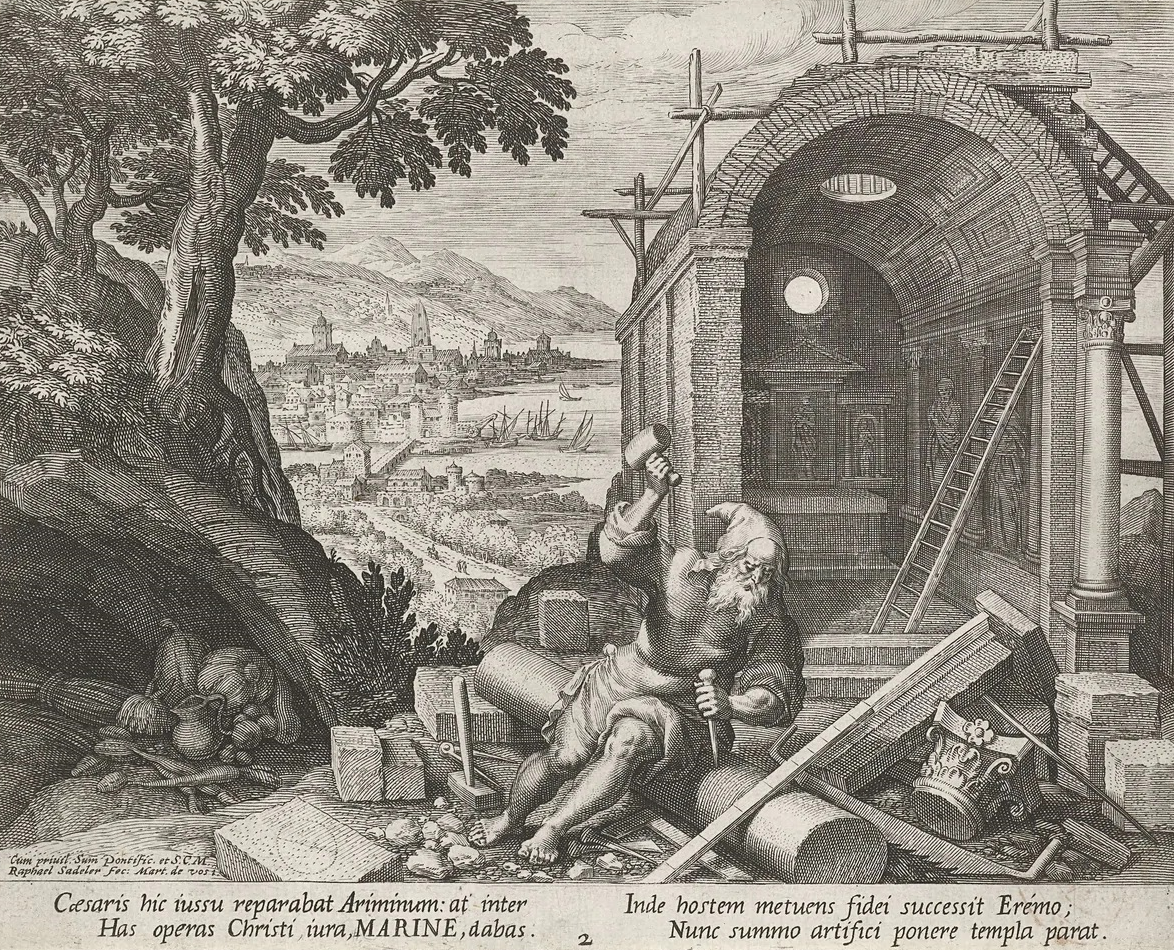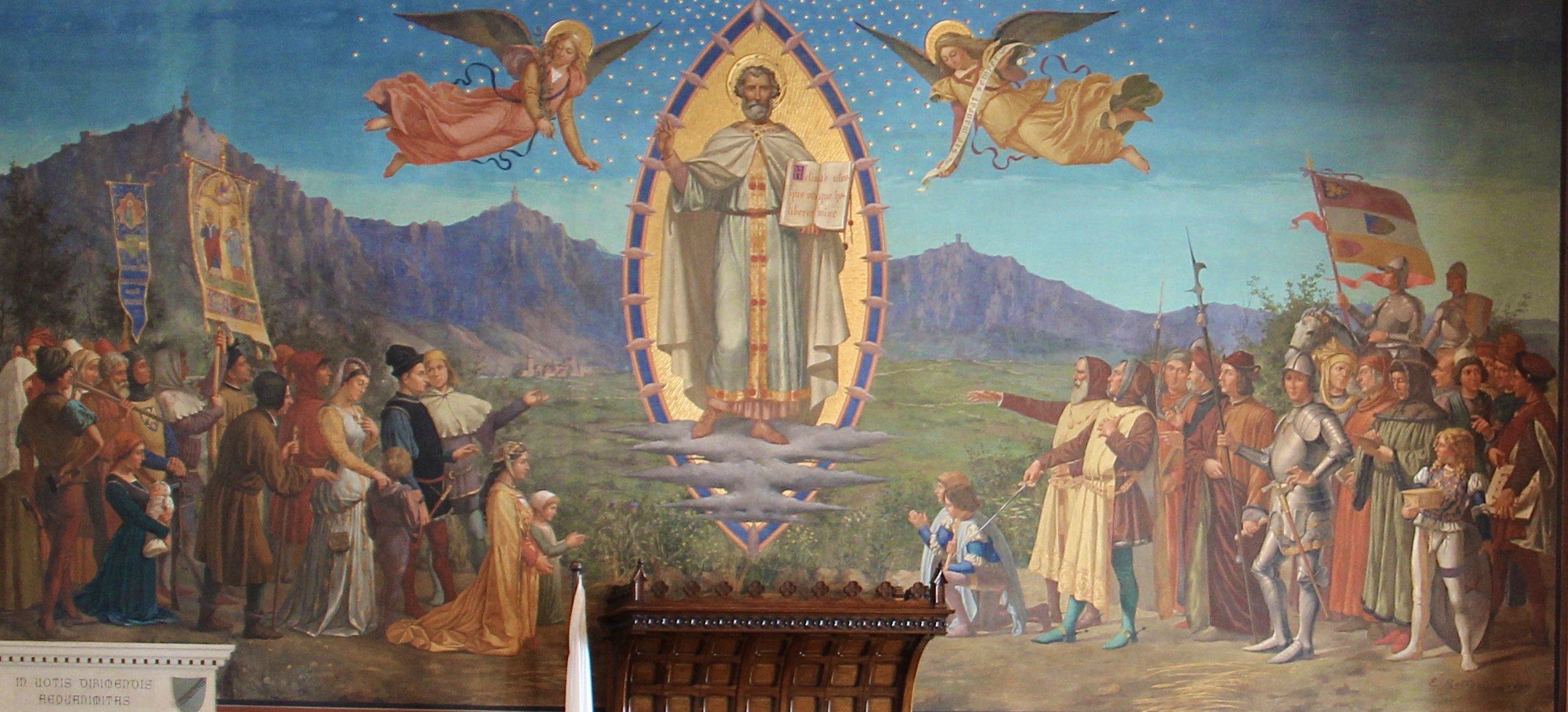Saint Marinus on:
[Wikipedia]
[Google]
[Amazon]
Saint Marinus (; it, San Marino) was an
 Known only by the single name ''Marinus'' (lit. of the sea), he became a Deacon, and was ordained by Gaudentius, the
Known only by the single name ''Marinus'' (lit. of the sea), he became a Deacon, and was ordained by Gaudentius, the  Marinus was canonised as a saint, and later, the State of San Marino grew up from the centre created by the monastery. His feast day/memorial day is 3 September, commemorating the day, in 301, when he founded what became known as
Marinus was canonised as a saint, and later, the State of San Marino grew up from the centre created by the monastery. His feast day/memorial day is 3 September, commemorating the day, in 301, when he founded what became known as
Link to journal.Link to copy of paper
Patron Saints Index: Saint Marinus
* {{DEFAULTSORT:Marinus Sammarinese Roman Catholic saints 3rd-century births 366 deaths History of San Marino People from the City of San Marino 4th-century Romans 4th-century Christian saints Republicans People from Rab Legendary Romans Hermits in the Roman Empire Diocletianic Persecution
Early Christian
Early Christianity (up to the First Council of Nicaea in 325) spread from the Levant, across the Roman Empire, and beyond. Originally, this progression was closely connected to already established Jewish centers in the Holy Land and the Jewish d ...
and the founder of a chapel and monastery in 301 from whose initial community the state of San Marino
San Marino (, ), officially the Republic of San Marino ( it, Repubblica di San Marino; ), also known as the Most Serene Republic of San Marino ( it, Serenissima Repubblica di San Marino, links=no), is the fifth-smallest country in the world an ...
later grew.
Life
Tradition holds that he was astonemason
Stonemasonry or stonecraft is the creation of buildings, structures, and sculpture using stone as the primary material. It is one of the oldest activities and professions in human history. Many of the long-lasting, ancient shelters, temples, mo ...
by trade who came from the island of Arba (today Rab
Rab �âːb( dlm, Arba, la, Arba, it, Arbe, german: Arbey) is an island in the northern Dalmatia region in Croatia, located just off the northern Croatian coast in the Adriatic Sea.
The island is long, has an area of and 9,328 inhabitants (2 ...
), on the other side of the Adriatic Sea
The Adriatic Sea () is a body of water separating the Italian Peninsula from the Balkan Peninsula. The Adriatic is the northernmost arm of the Mediterranean Sea, extending from the Strait of Otranto (where it connects to the Ionian Sea) to t ...
(in what is now part of modern-day Croatia
, image_flag = Flag of Croatia.svg
, image_coat = Coat of arms of Croatia.svg
, anthem = "Lijepa naša domovino"("Our Beautiful Homeland")
, image_map =
, map_caption =
, capit ...
, then part of the Roman Empire
The Roman Empire ( la, Imperium Romanum ; grc-gre, Βασιλεία τῶν Ῥωμαίων, Basileía tôn Rhōmaíōn) was the post-Republican period of ancient Rome. As a polity, it included large territorial holdings around the Mediterr ...
), fleeing persecution for his Christian
Christians () are people who follow or adhere to Christianity, a monotheistic Abrahamic religion based on the life and teachings of Jesus Christ. The words ''Christ'' and ''Christian'' derive from the Koine Greek title ''Christós'' (Χρι ...
beliefs in the Diocletianic Persecution
The Diocletianic or Great Persecution was the last and most severe persecution of Christians in the Roman Empire. In 303, the emperors Diocletian, Maximian, Galerius, and Constantius issued a series of edicts rescinding Christians' legal rights ...
.
 Known only by the single name ''Marinus'' (lit. of the sea), he became a Deacon, and was ordained by Gaudentius, the
Known only by the single name ''Marinus'' (lit. of the sea), he became a Deacon, and was ordained by Gaudentius, the Bishop of Rimini
The Diocese of Rimini ( la, Dioecesis Ariminensis) is a Latin Church ecclesiastical territory or diocese of the Catholic Church in Emilia Romagna, Italy. From earliest times, it was a suffragan to the Holy See, despite repeated attempts by the Di ...
; later, he was recognised and accused by an insane woman of being her estranged husband, so he quickly fled to Monte Titano
Monte Titano ("Mount Titan") is a mountain of the Apennines and the highest peak in San Marino. It stands above sea level and is located immediately to the east of the capital, San Marino. It was inscribed as a UNESCO World Heritage Site in 2008 ...
to build a chapel-monastery and live as a hermit.Radovan Radovinovič, ''The Croatian Adriatic Tourist Guide'', pg. 127, Zagreb (1999),
Another version of the story says that hearing that the town of Rimini (Italy) was being rebuilt, he travelled there and was astonished to find among the workmen many Christians of high birth who had been sentenced to hard labour because of their refusal to sacrifice to the gods. He sought to comfort them and to alleviate their sufferings, so far as was in his power. In his old age Marinus withdrew to a hermitage decided to seclude himself on Mount Titano, living the life of a hermit in holy contemplation. As his reputation for his sanctity grew, others started to follow him there, until finally a lady from Rimini and the owner of Mount Titano decided to gift him the mountain.
 Marinus was canonised as a saint, and later, the State of San Marino grew up from the centre created by the monastery. His feast day/memorial day is 3 September, commemorating the day, in 301, when he founded what became known as
Marinus was canonised as a saint, and later, the State of San Marino grew up from the centre created by the monastery. His feast day/memorial day is 3 September, commemorating the day, in 301, when he founded what became known as San Marino
San Marino (, ), officially the Republic of San Marino ( it, Repubblica di San Marino; ), also known as the Most Serene Republic of San Marino ( it, Serenissima Repubblica di San Marino, links=no), is the fifth-smallest country in the world an ...
, which is also the state's national holiday. He is venerated in the Roman Catholic and Eastern Orthodox faiths.
According to legend, he died in the winter of 366 and his last words were: "'" ("I leave you free from both men"). This somewhat mysterious phrase is most likely to refer to the two "men" from whose oppressive power Saint Marinus had decided to separate himself, becoming a hermit on Mount Titano: respectively the Emperor
An emperor (from la, imperator, via fro, empereor) is a monarch, and usually the sovereignty, sovereign ruler of an empire or another type of imperial realm. Empress, the female equivalent, may indicate an emperor's wife (empress consort), ...
and the Pope
The pope ( la, papa, from el, πάππας, translit=pappas, 'father'), also known as supreme pontiff ( or ), Roman pontiff () or sovereign pontiff, is the bishop of Rome (or historically the patriarch of Rome), head of the worldwide Cathol ...
. This affirmation of freedom (first and foremost fiscal franchise) from both the Empire
An empire is a "political unit" made up of several territories and peoples, "usually created by conquest, and divided between a dominant center and subordinate peripheries". The center of the empire (sometimes referred to as the metropole) ex ...
and the Papal States
The Papal States ( ; it, Stato Pontificio, ), officially the State of the Church ( it, Stato della Chiesa, ; la, Status Ecclesiasticus;), were a series of territories in the Italian Peninsula under the direct sovereign rule of the pope fro ...
, however legendary, has always been the inspiration of the tiny republic."The Republic of San Marino", William Miller, ''The American Historical Review'', Vol. 6, No. 4 (July 1901), pages 633–649Link to journal.
Sources
The earliest manuscripts mentioning Saint Marinus and his life date to the 10th century.Edwards, Adrian, and Chris Michaelides. San Marino. Vol. 188. Abc-Clio Incorporated, 1996, 19. Another principal source of the events of Marinus's life were compiled in theActa Sanctorum
''Acta Sanctorum'' (''Acts of the Saints'') is an encyclopedic text in 68 folio volumes of documents examining the lives of Christian saints, in essence a critical hagiography, which is organised according to each saint's feast day. The project w ...
.
See also
*History of San Marino
As the only surviving medieval microstate in the Italian peninsula, the history of San Marino is intertwined with the medieval, Renaissance and modern-day history of the Italian peninsula, according to tradition beginning with its foundation i ...
References
External links
Patron Saints Index: Saint Marinus
* {{DEFAULTSORT:Marinus Sammarinese Roman Catholic saints 3rd-century births 366 deaths History of San Marino People from the City of San Marino 4th-century Romans 4th-century Christian saints Republicans People from Rab Legendary Romans Hermits in the Roman Empire Diocletianic Persecution